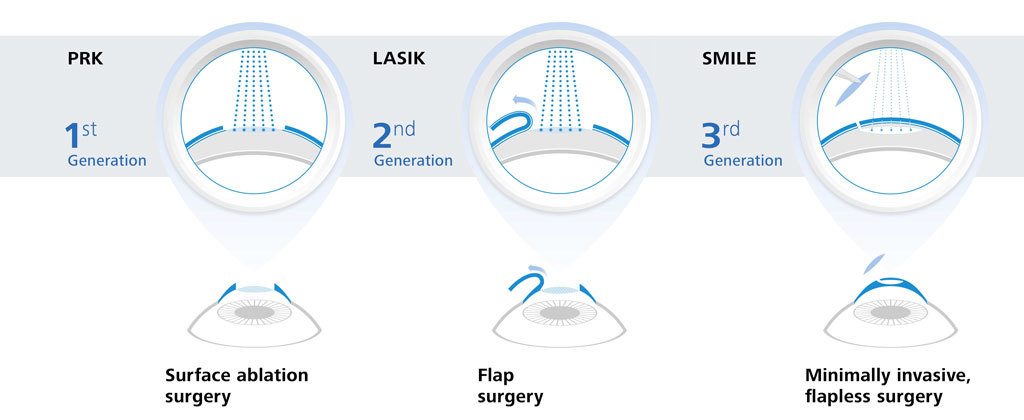What Are The Distinctions And Similarities In Between SMILE Eye Surgery, LASIK, And PRK?
What Are The Distinctions And Similarities In Between SMILE Eye Surgery, LASIK, And PRK?
Blog Article
Authored By-Adler Chase
If you've been considering SMILE eye surgical treatment, you might wonder how it compares to LASIK and PRK. Laser Eye Surgery Pricing has its own set of advantages and considerations. From quicker healing times to potential risks, there are crucial differences you ought to recognize before making a decision. Comprehending these distinctions will assist you make an educated option that lines up with your details demands and expectations. Curious to recognize even more concerning how these procedures compare thoroughly? Keep exploring to acquire a comprehensive understanding of SMILE, LASIK, and PRK.
SMILE Eye Surgical Procedure Summary
If you're thinking about SMILE eye surgical treatment, you'll discover it to be a minimally invasive procedure with a quick healing time. During SMILE (Little Incision Lenticule Extraction), a laser is made use of to produce a tiny, precise cut in the cornea to get rid of a small item of tissue, improving it to correct your vision. This differs from LASIK, where a flap is produced, and PRK, where the external layer of the cornea is entirely eliminated.
Among the crucial advantages of SMILE is its minimally intrusive nature, bring about a faster healing process and much less pain post-surgery. The recuperation time for SMILE is relatively fast, with many individuals experiencing boosted vision within a day or 2. This makes it a preferred selection for those looking for a hassle-free and reliable vision adjustment treatment. In addition, SMILE has actually been revealed to have a lower threat of completely dry eye disorder compared to LASIK, making it a favorable alternative for people concerned concerning this possible adverse effects.
Distinctions Between SMILE, LASIK, and PRK
When contrasting SMILE, LASIK, and PRK eye surgical procedures, it is very important to recognize the unique strategies utilized in each procedure for vision adjustment.
SMILE (Small Incision Lenticule Extraction) is a minimally invasive procedure that includes developing a little cut to draw out a lenticule from the cornea, improving it to remedy vision.
Bladeless LASIK Procedure (Laser-Assisted Sitting Keratomileusis) involves creating a slim flap on the cornea, making use of a laser to reshape the underlying tissue, and after that rearranging the flap.
PRK (Photorefractive Keratectomy) removes the external layer of the cornea before improving the cells with a laser.
The primary distinction hinges on the method the cornea is accessed and dealt with. SMILE is flapless, making it an excellent option for people with thin corneas or those involved in contact sporting activities. LASIK offers fast aesthetic recuperation as a result of the flap production, however it might position a higher threat of flap-related difficulties. PRK, although having a much longer recuperation period, stays clear of flap-related problems completely.
Recognizing these differences is critical in picking the most appropriate treatment for your vision correction requirements.
Advantages And Disadvantages Contrast
To review the benefits and disadvantages of SMILE, LASIK, and PRK eye surgical treatments, it's vital to take into consideration the specific benefits and possible constraints of each treatment. SMILE surgical procedure provides the benefit of a minimally invasive procedure, with a smaller sized cut and potentially quicker recovery time compared to LASIK and PRK. It also reduces the danger of completely dry eye post-surgery, an usual side effect of LASIK. However, SMILE might have restrictions in dealing with greater degrees of nearsightedness or astigmatism contrasted to LASIK.
LASIK surgery offers quick visual recuperation and very little discomfort during the treatment. It's highly reliable in dealing with a wide range of refractive errors, consisting of myopia, hyperopia, and astigmatism. Yet, LASIK carries a risk of flap problems, which can impact the corneal structure.
PRK eye surgical treatment, while not as prominent as LASIK, avoids developing a corneal flap, minimizing the danger of flap-related difficulties. It's suitable for individuals with thin corneas or uneven corneal surface areas. Nonetheless, PRK has a longer healing time and may entail more pain throughout the recovery procedure.
Conclusion
So, when it involves picking between SMILE, LASIK, and PRK, think about it like choosing the perfect pair of footwear. SMILE resembles a smooth, comfy set of sneakers - fast and easy.
LASIK is a lot more like fashionable high heels - showy and quick, yet with some potential threats.
should cataract surgery be done on both eyes is like tough hiking boots - reputable and durable, but requiring a little bit more effort and time.
Inevitably, the most effective choice depends on your specific needs and preferences.
